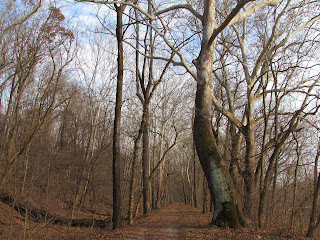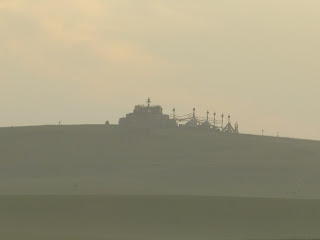The works of Charles Dickens
elicit strong responses. There are those who take great umbrage about the place
in Dickens occupies in literary canons. His contemporaries often found that his
work was wordy and tedious; some modern critics find him too didactic and
overly committed to idealized characters rather than real-life people.[1]
Yet, many of his works are considered classics, stories that continue to be
read in high schools and inspire films, plays, musicals and other works. More
so than any other, Dickens has become synonymous with the proper way to
celebrate Christmas. The emphasis on traditional meals, caroling, and
gift-giving can be traced to A Christmas
Carol, even if most people are unfamiliar with the underlying social
and political commentary that accompanies the novella.
 In Cambridge, Ohio during the
holiday season, I found evidence of this connection between the public
imagination and Charles Dicken. Each year, along Wheeling Avenue, this small
town erects nearly one hundred displays as a part of the annual “Dicken’s Victorian Village,”
recreating London Victorian Christmases of the 1850s. Up and down the sidewalks, in shop windows,
and even upon some second stories, mannequins display scenes from a holiday
season from our collective imagination. The displays attempt to balance the
idealized Christmas with the poverty and deprivation Dickens wrote about. For
example, a female mannequin is seated, exhausted, because she has no days off
during the holiday season and is expected to be constantly available to provide
her service. Another display shows an elderly woman begging from an upper-class
man. The accompanying sign from this display notes that there were few
respectable remunerative opportunities for females in the London of the 1850s.
Yet, most others describe decorating trees, depict Tiny Tim and Bob Cratchit,
and details of Dickens the man and his family. These are scenes that prompt
nostalgia for days gone by; an imagined simpler time. But juxtaposed are the
signs and symbols of the holiday season of the present, with more prosaic advertisements.
For example, a used car lot, not too far from Wheeling Avenue, beckons
potential customers with a sign that reads: “Naughty or Nice / Get a new car for
your wife.”
In Cambridge, Ohio during the
holiday season, I found evidence of this connection between the public
imagination and Charles Dicken. Each year, along Wheeling Avenue, this small
town erects nearly one hundred displays as a part of the annual “Dicken’s Victorian Village,”
recreating London Victorian Christmases of the 1850s. Up and down the sidewalks, in shop windows,
and even upon some second stories, mannequins display scenes from a holiday
season from our collective imagination. The displays attempt to balance the
idealized Christmas with the poverty and deprivation Dickens wrote about. For
example, a female mannequin is seated, exhausted, because she has no days off
during the holiday season and is expected to be constantly available to provide
her service. Another display shows an elderly woman begging from an upper-class
man. The accompanying sign from this display notes that there were few
respectable remunerative opportunities for females in the London of the 1850s.
Yet, most others describe decorating trees, depict Tiny Tim and Bob Cratchit,
and details of Dickens the man and his family. These are scenes that prompt
nostalgia for days gone by; an imagined simpler time. But juxtaposed are the
signs and symbols of the holiday season of the present, with more prosaic advertisements.
For example, a used car lot, not too far from Wheeling Avenue, beckons
potential customers with a sign that reads: “Naughty or Nice / Get a new car for
your wife.”
It is interesting to speculate
how Dickens might feel about the linkage between him and Christmas today. I am
sure that he would be flattered to think that his works, specifically A Christmas Carol, nearly 175-years old,
continues to be relevant and beloved. But in one of his lesser known works, The Chimes, written a year after A Christmas Carol, Dickens is
particularly suspicious of nostalgia and believing that there were “good old
days.” The primary protagonist in this novella is Toby Veck, who opens the
story with a prayer, muttered to himself, “I don’t know what we poor people are
coming to. Lord send we may be coming to something better in the New Year nigh
upon us!” Although it is frequently pointed out that Dickens was concerned
about the plight of the poor, the collective remembrance of A Christmas Carol tends to focus on the
spirit of Christmas and holiday traditions. But Dickens was also concerned
about how recounting the “good old times,” as he called it in The Chimes, served to discount the lives
of the poor. In remembering the “good old times,” no one ever talks about poverty
and deprivation. Toby comes to believe, because of the persistent nostalgia for
an undefined previous romanticized era, that the poor must accept sole blame for
their plight and are “born bad.” This relieves the intelligentsia and upper-classes
from any responsibility for the system, the alleviation of poverty, or
supporting the public tools, such as education, to help the poor escape the
situation. Surely, a lesson for the modern world as well.
[1] In
an editorial written in the Wall Street Journal, playwright David Mamet wrote
that the author’s work made him “vomit.” Mamet admits, however, that A Tale of Two Cities and A Christmas Carol are classics of
English language literature. David Mamet, “Charles Dickens Makes Me Want to
Throw Up,” Wall Street Journal, 22
July 2017.































